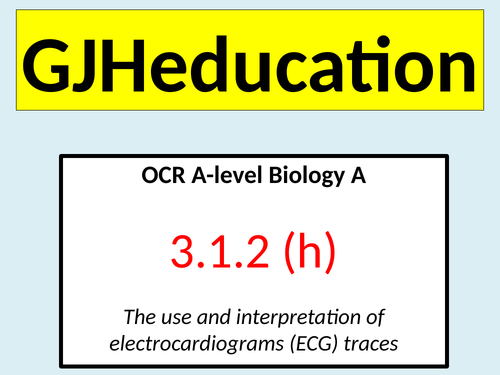





This fully-resourced lesson looks at the use and interpretation of electrocardiogram (ECG) traces and focuses on their use in the diagnosis of CVD and other heart conditions. The engaging PowerPoint and accompanying resources have been designed to cover point 3.1.2 (h) of the OCR A-level Biology A specification and continual links are made to linked topics from earlier in this module
The lesson has been written to take place in an imaginary cardiology ward where the students are initially challenged on their knowledge of the symptoms and risk factors of CVD before looking at testing through the use of ECGs and diagnosis. The main focus of the lesson is the ECG and a quiz competition is used to introduce the reference points of P, QRS and T before time is taken to explain their representation with reference to the cardiac cycle. Moving forwards, a SPOT the DIFFERENCE task is used to challenge the students to recognise differences between sinus rhythm and some abnormal rhythms including tachycardia and atrial fibrillation. Bradycardia is used as a symptom of sinus node disfunction and the students are encouraged to discuss this symptom along with some others to try to diagnose this health problem.
Get this resource as part of a bundle and save up to 44%
A bundle is a package of resources grouped together to teach a particular topic, or a series of lessons, in one place.
Module 3: Exchange and transport (OCR A-level Biology A)
This bundle contains 18 detailed and engaging lessons which cover the following specification points in module 3 (Exchange and transport) of the OCR A-level Biology A specification: 3.1.1: Exchange surfaces * The need for specialised exchange surfaces * The features of an efficient exchange surface * The structures and functions of the components of the mammalian gaseous exchange system * The mechanism of ventilation in mammals * The mechanisms of ventilation and gas exchange in bony fish and insects 3.1.2: Transport in animals * The double, closed circulatory system in mammals * The structure and functions of arteries, arterioles, capillaries, venules and veins * The formation of tissue fluid from plasma * The external and internal structure of the heart * The cardiac cycle * How heart action is initiated and coordinated * The use and interpretation of ECG traces * The role of haemoglobin in transporting oxygen and carbon dioxide * The oxygen dissociation curve for foetal and adult haemoglobin 3.1.3: Transport in plants * The structure and function of the vascular systems in the roots, stems and leaves * The transport of water into the plant, through the plant and to the air surrounding the leaves * The mechanism of translocation As well as the detailed A-level Biology content of the PowerPoint slides, the resources contain a wide range of tasks including guided discussion points, exam-style questions and quiz competitions which will engage and motivate the students
Module 3.1.2: Transport in animals (OCR A-level Biology)
Each of the 9 lessons in this bundle are fully-resourced and have been designed to cover the content as detailed in module 3.1.2 (Transport in animals) of the OCR A-Level Biology A specification. The specification points that are covered within these lessons include: * A double, closed circulatory system * The structure and function of arteries, arterioles, capillaries, venules and veins * The formation of tissue fluid from plasma * The internal and external structure of the mammalian heart * The cardiac cycle * How heart action is initiated and coordinated * The use and interpretation of ECGs * The role of haemoglobin in transporting oxygen and carbon dioxide * The dissociation curve for foetal and adult haemoglobin * The Bohr effect The lessons have been written to include a wide range of activities and numerous understanding and prior knowledge checks so students can assess their progress against the current topic as well as be challenged to make links to other topics within this topic and earlier topics If you would like to see the quality of the lessons, download the formation of tissue fluid. heart action and ECGs lessons as these are free
Something went wrong, please try again later.
very informative and useful resources...
Thank you - liked this as a task
Very interesting and concise, engaging resource for my class, thanks for sharing this resource!
Excellent, edited out some bits that were not applicable to the medical science diploma, and now it's perfect!
Excellent and interesting approach to teaching the main aspects of ECGs. Thanks for sharing.
Report this resourceto let us know if it violates our terms and conditions.
Our customer service team will review your report and will be in touch.